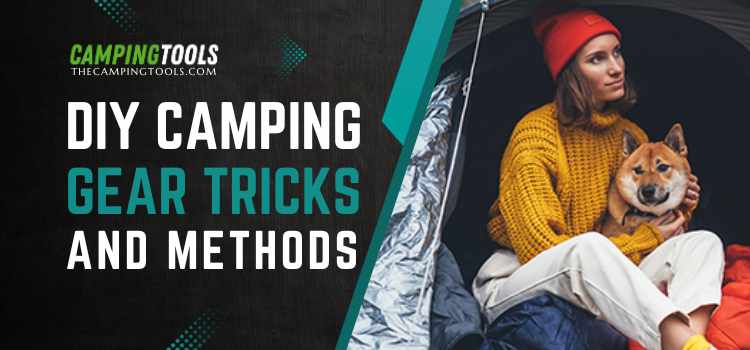Are you tired of spending a fortune on camping gear? Look no further, because we have the solution for you – DIY camping gear!
Not only will it save you money, but it also allows you to unleash your creativity and personalize your camping experience.
In this article, we’ll share some quick DIY camping gear tricks and methods that will make your next outdoor adventure even better.
Start by Planning Your Trip

Before you can start creating your own camping gear, you need to plan out your trip. This will help determine what type of gear you’ll need and how much space you’ll have to pack it. Consider the length of your trip, the weather conditions, and the activities you’ll be doing. This will give you a better idea of what items are essential and what can be left behind.
Trip Length Matters (DIY Camping Gear Methods)
For a weekend camping trip, you won’t need as much gear compared to a week-long trip. So think about how long you’ll be gone and pack accordingly. This will also help you determine the size of your backpack or storage bag.
Be Weather Prepared
Always check the weather forecast before heading out on a camping trip. If it’s going to be hot and sunny, you’ll need sun protection such as hats, sunscreen, and sunglasses. If it’s going to rain, pack waterproof gear like raincoats and tarps. Being prepared for the weather will ensure a comfortable camping experience.
Know Your Activities
Will you be hiking, fishing, or just relaxing by the campfire? Knowing your planned activities will help you determine what gear is necessary. For example, if you plan on hiking, lightweight and compact gear will be essential. If you’ll be fishing, make sure to bring along the appropriate equipment.
Choose the Right Materials for Camping Gear
When it comes to DIY camping gear, choosing the right materials is key. You want something that is durable, lightweight, and won’t break the budget. Some great options include using ripstop nylon fabric for tents, tarps, and hammocks, and closed-cell foam or inflatable pool noodles for sleeping pads.
Ripstop Nylon Fabric
Ripstop nylon is a popular choice for DIY camping gear because of its strength and durability. It is a woven fabric that has reinforced threads running through it to prevent tears from spreading. This makes it perfect for tents, tarps, hammocks, and other items that may be subject to wear and tear.
Closed-cell Foam or Inflatable Pool Noodles
Sleeping pads are an essential piece of camping gear, but they can take up a lot of space in your backpack. Instead of purchasing expensive sleeping pads, you can create your own using closed-cell foam or inflatable pool noodles. Both options are lightweight and easy to pack, making them ideal for backpacking trips.
Create a Versatile Camping Kitchen
Cooking while camping can be a challenge but with some everyday items and a little creativity, you can create an efficient and compact cooking setup. For example, use a large coffee tin as a stove – simply punch holes in the lid for ventilation and fill it with charcoal. You can also use a metal cooling rack as a grill over the fire, or use a small tackle box to store spices and cooking utensils.
Use a Coffee Tin as a Stove
A large coffee tin can easily be transformed into a camping stove with just a few simple steps. First, remove the lid and punch holes in it for ventilation. Then, fill the tin with charcoal and light it up for an instant camp stove. This is a quick and easy way to cook meals while camping.
Get Creative with a Cooling Rack
A metal cooling rack can be used as a grill over the fire. Simply place it on top of some rocks or logs and use it to cook your food directly over the flames. This is a great alternative to bulky, traditional camping grills and allows for more flexibility in cooking.
Organize with a Tackle Box
Using a small tackle box to store spices and cooking utensils is a great way to stay organized while camping. The compartments are perfect for separating different spices and the small size makes it easy to pack along with your other gear.
Make Your Own Sleeping Bags and Mats
Sleeping bags and mats can be expensive, but you can easily make your own using simple sewing skills. Look for tutorials online on how to create a custom sleeping bag or mat from scratch. Not only will this save you money, but it also allows you to customize the size and materials used.
Crafting Custom Sleeping Bags and Mats
By utilizing simple sewing skills, you can create custom sleeping bags and mats from scratch. This allows for more customization in size, materials, and design. Plus, making your own gear adds a personal touch to your camping experience. Look for tutorials online for step-by-step instructions on how to craft your own sleeping bag or mat.
Tips for Making Your Own Sleeping Bags and Mats
- Research different materials and choose ones that are durable and lightweight
- Practice sewing techniques before tackling the final product
- Use a backpacking sleeping bag as a reference for size and design
- Consider adding extra insulation for colder camping trips
Utilize Nature’s Resources for Shelter
When camping, nature can be your biggest ally. Instead of bringing heavy and bulky tarps and tents, try finding natural resources like trees, leaves, vines, and sticks to create your own shelter. This not only saves space and weight in your pack, but it also allows you to blend in with the environment.
How to Use Nature’s Resources for Shelter
- Look for sturdy trees or branches to use as a base for your shelter.
- Gather leaves and vines to create a natural roof.
- Use sticks or logs as support beams.
- Be mindful of your surroundings and avoid damaging the environment.
Build a Fire Starter Kit with Household Items
A fire is essential for cooking, staying warm, and providing light while camping. Instead of relying on store-bought fire starters, try making your own using common household items. Some ideas include cotton balls coated in petroleum jelly, dryer lint, and wax, or even Doritos chips.
Why Make Your Own Fire Starter Kit?
- Saves money on expensive store-bought fire starters.
- Easy to make with common household items.
- An environmentally friendly alternative to store-bought options.
- Can be customized to fit your specific needs.
How to Make a DIY Fire Starter Kit
- Gather materials such as cotton balls, petroleum jelly, dryer lint, wax, or Doritos chips.
- Coat the cotton balls in petroleum jelly and store them in a waterproof container.
- Mix dryer lint with melted wax and pour into small molds to create fire starters.
- Crush up Doritos chips and use them as kindling for starting a fire.
- Store all items in a compact container for easy transport.
Put Together an Emergency Kit
It’s always important to be prepared for unexpected occurrences while camping. Make sure to pack a first aid kit, extra food and water, a map and compass, and other essential items in case of emergency. You can also consider bringing a portable water filtration system or a satellite phone for added safety.
Why Have an Emergency Kit?
- Safety in case of unexpected occurrences.
- Peace of mind for you and your fellow campers.
- Can help prevent minor injuries from becoming major emergencies.
What to Include in Your Emergency Kit
- First aid kit with bandages, pain relief medication, and other medical supplies.
- A map and compass or GPS device for navigation.
- Non-perishable food items and extra water.
- Portable water filtration system or purification tablets.
- A satellite phone or emergency beacon for communication in case of no cell service.
- Extra warm clothing, rain gear, and a waterproof shelter.
- Flashlight and extra batteries.
- Multi-purpose tool or knife.
- Basic survival gear such as a whistle, signal mirror, and emergency blanket.
- Any necessary medication or personal items.
Tips for Packing Your Emergency Kit
- Keep all items in a waterproof container or bag to prevent damage from rain or water.
- Make sure to periodically check and restock your emergency kit before each camping trip.
- Consider having multiple smaller kits that can be easily carried on hikes or during other activities.
- Be familiar with how to use all the items in your emergency kit before heading out on your trip.
Go Lightweight with DIY Backpacks and Gear Storage Solutions
When backpacking, weight and space are crucial factors to consider. Get creative with your gear storage by using lightweight materials like nylon or mesh to make your own stuff sacks and compression bags. You can also use empty plastic bottles as makeshift water containers or a garbage bag as a rain cover for your backpack.
DIY Backpacks and Gear Storage Solutions
One of the biggest challenges when camping or backpacking is finding ways to pack efficiently without sacrificing essential items. That’s where DIY backpacks and gear storage solutions come in handy. By creating your own lightweight bags and storage options, you can save space and reduce weight while still having all the necessary equipment for a successful trip.
Making Your Own Stuff Sacks
Stuff sacks are great for organizing and compressing your gear, but they can be expensive. To save money and customize the size and shape of your stuff sacks, try making them yourself using lightweight materials such as nylon or mesh. You can find tutorials online on how to sew your own stuff sack in any size you need.
Using Plastic Bottles for Water Storage (DIY Camping Gear Methods)
Water is essential when camping, but carrying multiple bulky water bottles can take up a lot of space and add unnecessary weight to your pack. Instead, try using empty plastic bottles as makeshift water containers. They are lightweight, easy to refill, and can be easily crushed or disposed of when finished.
Repurposing a Garbage Bag as a Rain Cover
One of the worst things that can happen while camping is getting caught in a rainstorm without proper gear. To avoid this situation, always pack a rain cover for your backpack. If you don’t have one, no need to worry! A large garbage bag can be used as a makeshift rain cover by simply cutting holes for your straps and covering your pack.
Conclusion: DIY Camping Gear Tricks
Camping can be an enjoyable and budget-friendly experience with the help of DIY tricks and methods. By planning ahead, utilizing natural resources, creating your own gear, and being prepared for emergencies, you can have a successful camping trip without breaking the bank. So next time you’re headed into the great outdoors, don’t forget to pack your DIY camping gear and get ready for an unforgettable adventure.
Happy camping!
FAQs: DIY Camping Gear Tricks
What are some good camping hacks?
Camping can be a fun and exciting experience, but it can also come with its challenges. That’s where camping hacks come in handy! Some of our favorite camping hacks include using rocks to secure your tent, creating a makeshift lantern with a headlamp and water bottle, and using an old pool noodle as a makeshift doorstop. These simple tricks can make your camping trip a lot easier and more enjoyable.
How can I make my camping more luxurious?
Camping doesn’t have to mean roughing it in the wilderness. With a few DIY tricks, you can add some luxury to your camping experience. For example, you can create your own portable shower using a large water jug and a watering can head. You can also make your own comfortable camping bed by layering an air mattress with foam mats and a fitted sheet. And don’t forget to bring some battery-operated string lights to add a cozy ambiance to your campsite.
How can I make my campsite fun?
Camping is all about having fun and making memories, so why not add some activities to your campsite? You can create your own outdoor movie theater by hanging a white sheet between two trees and using a portable projector. Or you can set up a scavenger hunt for the kids (or adults!) to explore nature around the campsite. And don’t forget to bring some card games or board games for some good old-fashioned fun.
How can I make camping life easier?
Camping can be quite challenging, especially when it comes to packing and organizing all your gear. To make things easier, start by planning your trip and making a list of the essential items you’ll need. This will help you determine what type of gear you’ll need and how much space you have to pack it. When selecting materials for your camping gear, go for durable and lightweight options that won’t break the budget. And if you’re looking to save some money, consider repurposing items from your home instead of buying new gear.
What are some tips for creating a versatile camping kitchen?
A well-equipped camping kitchen can make a huge difference in the overall camping experience. But you don’t have to invest in expensive equipment to have a functional kitchen. Instead, use everyday items to craft an efficient and compact cooking setup. For example, you can turn a plastic storage bin into a portable sink by adding a spigot and using it as a water source for washing dishes. You can also use pots and pans from your home kitchen or opt for lightweight camping-specific options.






